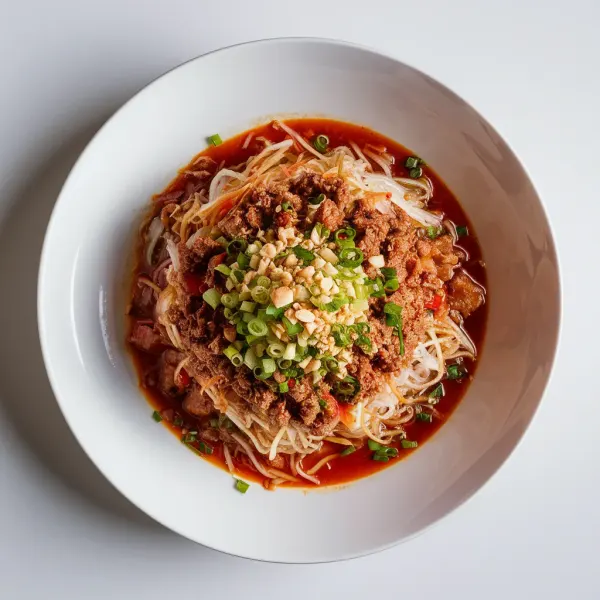
 30 minutes
30 minutesA traditional dish featuring tender pork in a rich tomato sauce, served over rice noodles with an array of customizable toppings.


tablespoons
teaspoons
Shallots, thinly sliced
cups
Garlic, minced
tablespoons
Pork Tenderloin, cut into cubes less than ½ inch across
0 lb
cups
Fermented Soybean Paste
tablespoons
tablespoons
Five-Spice Powder
teaspoons
teaspoons
1. Infuse Oil with Turmeric
In a large heavy pot or wok, heat the peanut oil over medium heat. Add the turmeric and let it infuse the oil for a few seconds.
2. Cook Shallots and Garlic
Add the thinly sliced shallots and cook for about 3 to 4 minutes, until they turn translucent. Follow with the minced garlic and cook for another minute to release its fragrance.
3. Brown the Pork
Add the cubed pork to the pot. Stir well, ensuring that each piece of pork is coated with the flavorful oil. Cook until the pork changes color, which should only take a few minutes.
4. Simmer with Tomatoes
Pour in the crushed tomatoes. Bring the mixture to a boil, then reduce heat and let it simmer for about 10 minutes.
5. Add Seasonings
Stir in the fermented soybean paste (or miso paste), fish sauce, Five-Spice Powder, and salt. Taste and adjust the seasoning if needed.
6. Cook Rice Noodles
Meanwhile, bring a large pot of water to a boil. If using fresh rice noodles, cook for about 1 minute. For dried rice noodles, cook for about 4 minutes. Once cooked, drain the noodles thoroughly.
7. Prepare Toppings
Prepare the optional toppings and condiments, setting them out in individual bowls.
8. Assemble and Serve
Distribute the cooked noodles among serving bowls and top with the pork and tomato sauce. Add preferred toppings and condiments. Serve immediately.
Start with the freshest and highest-quality ingredients available. Heritage pork will add depth to the flavor profile. If you can't find heritage pork, opt for organic, pasture-raised pork for the best taste.
Sear the pork in a hot pan to develop a flavorful crust, but be careful not to overcook it. Keep it tender and juicy by using a thermometer to check for doneness (145°F for pork).
Marinate the pork to infuse it with flavors. Use traditional Burmese spices and perhaps a hint of soy or fish sauce for umami. Allow the pork to marinate for at least an hour, or ideally overnight, for maximum flavor penetration.
Build your sauce by toasting spices before adding liquids. This releases their essential oils and deepens the final taste of your dish. Consider spices like turmeric, cumin, and coriander common in Burmese cuisine.
Don’t rush sautéing your onions, garlic, and ginger. Cook them until they're fragrant and golden to create a flavor foundation that will carry through the dish.




Comments (0)